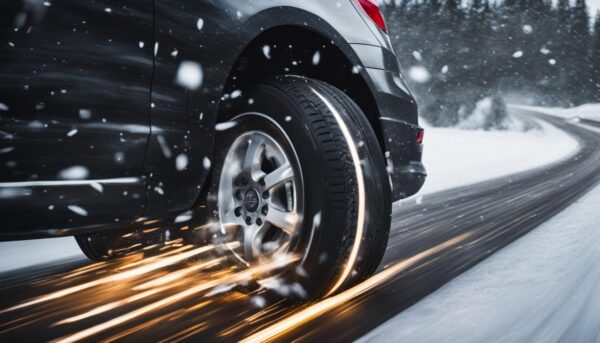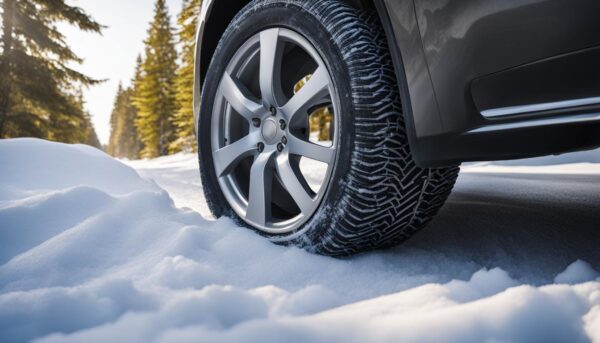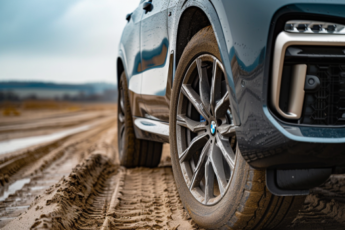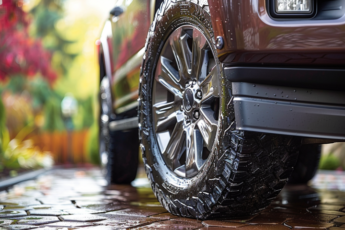Last Updated on 4 weeks
Discover How All-Weather Tires Outperform in Snowy Conditions
As winter approaches, many drivers look for tires that can handle snowy conditions without sacrificing year-round performance. **All-weather tires** are emerging as a versatile solution, offering impressive snow traction and a consistently reliable grip throughout the year. But what sets these snow-ready tires apart from standard all-season options, and how do they perform in snowy conditions? Keep reading to learn why all-weather tires have become an increasingly popular choice for drivers who want dependable performance in the snow without needing seasonal tire changes.
Key Takeaways
- All-weather tires offer enhanced performance and snow traction compared to regular all-season tires, making them a practical choice for drivers who experience occasional snowfall.
- The unique rubber compounds and tread designs of all-weather tires remain flexible in low temperatures, providing a secure grip on snowy and icy roads.
- Deeper treads in all-weather tires help manage snow buildup, ensuring optimal traction and handling in winter conditions.
- All-weather tires combine the advantages of both all-season and winter tires, allowing drivers to maintain year-round performance in various climates without frequent tire changes.
- Some top-rated all-weather tires for snowy conditions include the Goodyear Assurance WeatherReady, Michelin CrossClimate +, Nokian WRG4, Toyo Celsius, and Vredestein Quatrac 5.
Understanding All-Weather Tires and Their Unique Composition
All-weather tires provide an outstanding balance between year-round capabilities and superior winter performance. The key to their effectiveness lies in their unique composition, including advanced rubber compounds and meticulously engineered tread designs. Let’s delve into the details of these features that enable all-weather tires to deliver exceptional traction in winter conditions.
The Technology Behind All-Weather Tire Rubber Compounds
One crucial aspect of all-weather tire technology is the innovative rubber compounds used in their construction. These compounds are designed to remain flexible in cold temperatures, ensuring the tires maintain optimal grip on icy and snowy roads. This flexibility prevents the common issue of tire stiffening experienced with summer or standard all-season tires, which results in compromised traction and reduced safety during winter driving.
Flexible tread rubber is pivotal for a tire’s cold temperatures performance, allowing it to maintain a firm grip on winter roads and ensuring reliable handling in adverse conditions.
Assessing Tread Designs for Optimal Snow Performance
Apart from the rubber compounds, the tread designs of all-weather tires play a significant role in their snow performance. These tires possess deeper treads than regular all-season tires, which help manage snow buildup and enhance grip on icy surfaces. The deeper impressions allow for improved road contact and facilitate the smooth expulsion of snow and slush away from the tire.
- Strategically engineered tread patterns effectively channel snow and slush away from the tire.
- Abundant biting edges within the tread blocks drastically improve traction on winter roads.
- Deeper treads ensure continuous grip, providing excellent traction in winter conditions.
These various features work together to deliver superior snow traction in all-weather tires. By incorporating flexible rubber compounds and advanced tread designs, drivers can confidently navigate winter conditions with increased safety and control.
Comparing All-Weather Tires to Winter-Specific Options
All-weather tires compromise between summer and winter performance capabilities, providing sufficient traction for mild winter driving conditions. However, winter-specific tires might be a better option for those facing extreme cold, ice, and snow due to their specialized rubber compounds and tread designs.
These tires are engineered to handle winter conditions more effectively by staying pliable in cold weather and having treads that grip through snow and ice. Let’s dive deeper into the differences between all-weather tires and winter-specific options regarding temperature performance and specialized tread design.
Temperature Performance
Winter tires are designed to perform optimally in temperatures below 45ºF (7ºC), while all-weather tires perform well across a broader range of temperatures, making them suitable for year-round use. The rubber compounds in winter tires are created to maintain flexibility and grip on the road, even in frigid conditions.
All-weather tires are a versatile option for those who encounter mild winter conditions, but for those in areas with extreme cold, ice, and snow, winter-specific tires are the safer, more effective choice.
Specialized Tread Design
All-weather and winter tires excel in dealing with snowy conditions, but winter tires have the edge when tackling extreme weather challenges. Winter tire treads feature a higher concentration of sipes and biting edges that help grip ice and snow better while maintaining traction and control on slippery surfaces.
Though all-weather tires include deeper treads and other features that work well in mild winter conditions, they cannot compete with winter tires when driving on thick snow or icy roads.
| Tire Type | Temperature Performance | Tread Design |
|---|---|---|
| All-Weather Tires | Wide temperature range | Deeper treads and enhanced features for mild winter conditions |
| Winter Tires | Optimal performance below 45ºF (7ºC) | Specialized tread design for excellent grip on thick snow and ice |
In conclusion, all-weather tires are a great choice if you live in a region with moderate winter conditions and are looking for a year-round tire solution. However, winter-specific tires are safer and more effective if you frequently face extreme cold, ice, and heavy snowfall.
The Role of Tread Depth in Snow Traction
As winter conditions set in and roads become covered in snow and slush, the role of your tire’s tread depth becomes increasingly essential. Understanding how tread depth affects snow traction can be the key to a safer and more comfortable driving experience. Let’s dive deeper into why deeper treads matter in winter conditions.
Why Deeper Treads Matter in Winter Conditions
Tread depth plays a pivotal role in snow traction for all-weather tires. Deeper treads provide several benefits that contribute to improved performance during adverse winter conditions:
- Reduced snow buildup: As the treads on a tire are more profound, they allow for a reduced accumulation of snow within the tracks. This helps maintain better contact with the road surface, improving grip and stability.
- Expelling water and slush: Deeper treads are advantageous in removing water and slush from beneath the tire, ensuring continuous traction and minimizing the risk of hydroplaning.
- Biting through snow: A tire with deeper treads can “bite” through loose snow and icy layers, offering more consistent traction in winter conditions.
To illustrate the importance of deep treads in winter, consider how a tire with worn treads might struggle to maintain traction on a snowy road. The shallow impressions are more easily packed with snow and ice, resulting in a slippery surface and significantly reduced grip. Additionally, the external images have a more challenging time expelling water and slush, potentially leading to hydroplaning or inconsistent grip on wet road surfaces.
“Deeper treads provide improved traction, grip, and stability in winter conditions by reducing snow buildup and effectively expelling water and slush.”
In conclusion, the role of tread depth in snow traction cannot be underestimated. Deeper treads are an essential feature of all-weather tires designed to provide reliable performance in winter conditions. By understanding the advantages of deeper treads, drivers can make informed decisions when selecting their next set of tires, ensuring better traction, grip, and stability during the colder months.
Speed Ratings and Safety: How They Impact Tire Performance in Snow

Speed ratings, represented by letters S, T, H, and V, significantly impact tire safety and tire performance in snow. These ratings indicate the maximum Speed a tire is engineered to support. While they do not suggest safe operating speeds for regular driving, they are linked to the tires’ ability to manage heat buildup and provide related performance attributes such as handling and wet grip.
Higher-rated tires, like those with a V rating for maximum speeds of 149 mph, tend to offer better handling and wet grip. This can contribute positively to their performance in snowy conditions. To better understand the performance implications related to different speed ratings, consider the following table:
| Speed Rating | Maximum Speed (mph) | Features |
|---|---|---|
| T | 118 | Standard touring tires with balanced performance in wet and dry conditions |
| H | 130 | Better handling and performance at high speeds, suitable for sporty sedans |
| V | 149 | Improved cornering and handling, typically found on performance or luxury vehicles. |
| Z | 150+ | Ultra-high-performance tires designed for use on sports cars and high-performance vehicles |
A tire’s speed rating directly relates to its overall performance in various conditions. This translates to how effectively they can handle slippery roads, maintain traction, and offer a comfortable driving experience in winter. Choosing a tire with the correct speed rating for your needs is essential, considering both speed capabilities, handling, and wet grip features that will ensure a confident and safe driving experience during winter.
As tires with higher speed ratings tend to be designed for more demanding driving conditions, they may also provide an improved response to temperature fluctuations and challenging road conditions, which are highly relevant in snowy environments.
Remember, selecting the right speed rating for your tires is crucial – it ensures that your vehicle maintains optimal performance in varying conditions, ultimately contributing to enhanced safety during the winter months.
Top-Rated All-Weather Tires for Snowy Conditions
Several models have proven their worth in consumer testing regarding top-rated all-weather tires for snowy conditions. This section will review the market’s favorite all-weather tires, highlighting their features and performance in snowy environments.
Reviewing the Market’s Favorite All-Weather Tires
Based on all-weather tire reviews, here are the best all-weather tires that have excelled in terms of grip and overall snow capability:
- Goodyear Assurance WeatherReady
- Michelin CrossClimate +
- Nokian WRG4
- Toyo Celsius
- Vredestein Quatrac 5
These tires have been tested on common platforms, such as Toyota Camrys, and have demonstrated significant differences in performance, ultimately becoming drivers’ favorite tires for snow.
| Tire Model | Dry Traction | Wet Traction | Snow Capability | Tread Life |
|---|---|---|---|---|
| Goodyear Assurance WeatherReady | Excellent | Excellent | Very Good | Good |
| Michelin CrossClimate + | Very Good | Excellent | Excellent | Excellent |
| Nokian WRG4 | Good | Very Good | Excellent | Very Good |
| Toyo Celsius | Good | Good | Very Good | Good |
| Vredestein Quatrac 5 | Very Good | Very Good | Good | Very Good |
“I’ve been using the Michelin CrossClimate+ on my Toyota Camry for the past few winters, and the tires have provided me with excellent snow performance and impressive tread life. I couldn’t be happier with my decision.”
As evident from the table and testimonials from satisfied drivers, the top-rated all-weather tires listed above provide a range of features and performance levels suitable for various snowy conditions. Ultimately, the choice between these tires will depend on each driver’s specific needs and priorities, such as dry and wet traction levels, snow performance, and tread life.
Cost Efficiency: Balancing Tread Life with Snow Capability

Cost efficiency in all-weather tires is primarily influenced by their balancing act between tread life and snow capability. These elements play a significant role in the overall expense related to tires, including purchasing, mounting, balancing, and recycling costs. Comparing the cost per mile can offer valuable insights for drivers when considering the benefits of all-weather tires.
Selecting the right all-weather tires involves understanding the trade-offs between longevity and winter performance. A longer tread life can contribute to a lower cost per mile, while optimal snow capability ensures safety and reliability during winter.
Finding the right balance between tread life and snow capability is crucial when seeking cost efficiency in all-weather tires.
Aside from the initial investment in purchasing the tires, other related expenses include tire changing costs. Frequent changes due to poor tread life or reduced snow capability can inflate overall fees for owning and maintaining all-weather tires.
- Research and compare different tire brands and models to understand their performance characteristics, including tread life and snow capability.
- When comparing different all-weather tire options, factor in tire changing costs, including mounting and balancing.
- Evaluate the cost per mile to decide when selecting the ideal all-weather tires.
| Brand | Model | Tread Life | Snow Capability | Cost per Mile |
|---|---|---|---|---|
| Goodyear | Assurance WeatherReady | 60,000 miles | Excellent | $0.09 |
| Michelin | CrossClimate+ | 50,000 miles | Superior | $0.10 |
| Nokian | WRG4 | 55,000 miles | Very Good | $0.08 |
| Toyo | Celsius | 60,000 miles | Good | $0.11 |
| Vredestein | Quatrac 5 | 40,000 miles | Excellent | $0.15 |
By mindfully considering and comparing the cost per mile, tread life, and snow capability, consumers have the tools to make informed decisions about their all-weather tire purchases. This knowledge ultimately leads to greater cost efficiency and safer, more enjoyable winter driving experiences.
Navigating Roadways Safely: The Advantage of All-Weather Tires in Winter
Winter driving can be challenging, with snow and ice significantly threatening motorists. All-weather tire safety is crucial in navigating roadways safely during these colder months. With their unique design features and technology, these tires provide drivers with enhanced traction, stability, and reliability in harsh winter conditions, ensuring a safer driving experience.
All-Weather Tire Safety Features for Snowy and Icy Roads
All-weather tires have several key safety features designed to improve their performance on snowy and icy roads. These features include:
- Flexible tread rubber: All-weather tires use a specialized rubber compound that remains pliable and flexible in cold temperatures, unlike standard all-season or summer tires. This flexibility allows the tires to maintain a better grip on icy and snow-covered roads as they stay in better contact with the surface.
- Deeper tread depths: These tires possess deeper treads than regular all-season tires, which help reduce the buildup of snow on the tire and enhance grip. This ensures continuous traction in adverse winter conditions, providing a safer driving experience.
- Increased sipes and biting edges: The tread patterns in all-weather tires have more sipes (tiny slits within the tread blocks) and biting edges. These features significantly improve traction on slick surfaces, enabling the tire to grip better on snow and ice.
All-weather tires provide drivers with an advantage when navigating snowy and icy roads. Their design elements enhance their ability to maintain traction and stability in winter conditions, offering a safer and more reliable driving experience during the colder months.
Ultimately, incorporating all-weather tire safety features into your vehicle can be a game-changer for winter driving. These tires cater to the specific challenges of navigating roadways in snow and ice, providing a safer and more secure driving experience.
The Importance of Biting Edges in Snow and Ice
Biting edges are critical in all-weather tire performance on snow and ice. These tiny slits within the tread blocks provide additional gripping action that significantly improves traction on slick surfaces. The higher density of biting edges on all-weather tires compared to standard all-season tires allows for more pronounced traction capabilities in various wintry road conditions, including snow and sleet.
Understanding the biting edges’ importance in all-weather tires is crucial for drivers frequently encountering snow and ice on their journeys. The main factors contributing to the enhanced grip and traction on snowy and icy surfaces include the design and density of the biting edges and sipes, significantly impacting the overall tire performance.
Increased traction on ice and snow road grip can be attributed to the design and density of biting edges and sipes in all-weather tires.
Let’s take a closer look at the critical elements of biting edges and sipes:
- Biting edges: These are the sharp edges around the tire tread blocks, created by small slits or cuts in the rubber. These edges dig into the snow and ice, providing crucial traction for the tire.
- Sipes: Small, narrow slits that are cut into the tire tread blocks to create more biting edges. Sipes enhance the tire’s grip on tricky surfaces, improving traction on icy and snowy roads.
The density of biting edges and sipes is essential in determining a tire’s performance in winter. Tires with higher sipe densities have more biting edges, which can provide better traction and snow road grip.
| Tire Type | Tread Design | Biting Edges Density |
|---|---|---|
| Standard All-Season Tire | Regular tread blocks with minimal siping | Lower biting edge density |
| All-Weather Tire | Deeper tread blocks with higher sipe densities | Higher biting edge density |
When searching for the best tires for winter driving, it is essential to consider the biting edges’ importance and the tire’s sipe density. By choosing all-weather tires with higher densities of cutting edges, drivers can ensure improved traction and safety on ice and snow-covered roads.
Maintaining Performance in Cold Climates with Low Rolling Resistance All-Weather Tires
When driving in cold climates, performance and fuel efficiency are two of the most critical factors. Low-rolling resistance all-weather tires are designed to cater to these needs, providing an optimal blend of efficiency, safety, and cold climate performance. These tires minimize energy loss during rolling, reducing fuel consumption and emissions and making them an ideal choice for drivers navigating colder environments.
Low rolling resistance all-weather tires are engineered to provide a balance of safety, performance, and efficiency in cold climates.
One of the critical aspects of maintaining tire performance in cold climates is ensuring that the tires can maintain their traction and grip on snowy and icy road surfaces. This is possible due to the unique composition of low-rolling resistance all-weather tires, which remain flexible in low temperatures and provide a firmer grip in various winter driving conditions.
Furthermore, low-rolling resistance all-weather tires are specifically designed with deeper treads and more biting edges for improved traction on snow and ice. These features, paired with their efficient rolling resistance design, ensure that drivers enjoy a safe, eco-friendly, and fuel-efficient driving experience even in the harshest cold climates.
| Benefits of Low Rolling Resistance All-Weather Tires |
|---|
| Enhanced cold climate performance |
| Improved fuel efficiency |
| Reduced emissions |
| Better traction and grip on snowy and icy surfaces |
In conclusion, low rolling resistance all-weather tires are an excellent choice for drivers who prioritize safety, performance, and fuel efficiency in cold climates. With their unique composition and design, these tires ensure a secure and environmentally friendly driving experience, maintaining tire performance in even the most challenging winter conditions.
Conclusion: Making the Right Choice in Snow-Ready Tires
Finding the perfect snow-ready tires entails a deep understanding of the unique features of all-weather tires and how they measure up to standard all-season or winter-specific options. All-weather tires offer a practical and efficient solution for drivers living in moderate climates with occasional snowfall, granting the convenience of year-round usage without the need for seasonal tire changes.
However, dedicated winter tires might be the most suitable for those with severe winter conditions. The decision should ultimately be based on an individual’s specific driving needs and local weather patterns, factoring in the all-weather tire benefits and comparing them to other tire types.
Snow-ready tire selection involves choosing based on specific needs and circumstances. By considering factors such as climate, road conditions, driving habits, and budget, you can ensure a safe and comfortable driving experience throughout the year.
FAQ
What are the main benefits of all-weather tires in snowy conditions?
All-weather tires offer enhanced snow traction, flexible tread rubber, and deeper tread depths than standard all-season tires. These features improve grip, stability, and performance on snowy and icy roads.
How does the rubber compound in all-weather tires contribute to better performance in cold temperatures?
The rubber compounds of all-weather tires are designed to remain flexible in low temperatures, preventing the tires from stiffening. This flexibility is crucial for maintaining a firm grip on cold and snowy roads, ensuring better performance in winter conditions.
How do tread designs in all-weather tires help with snow traction?
All-weather tires have deeper tread depths and specific tread patterns that effectively channel snow and slush away from the tire. This helps manage snow buildup and enhances grip on winter roads, ensuring better performance in snowy conditions.
How do all-weather tires compare to winter-specific tires?
While all-weather tires offer a practical and efficient solution for drivers in moderate climates with occasional snow, dedicated winter tires provide specialized rubber compounds and tread designs engineered to handle more severe winter conditions more effectively.
How do deeper treads in all-weather tires improve performance in winter conditions?
Deeper treads help reduce snow buildup within the tire treads, maintaining better contact with the road surface. They also expel water and slush beneath the tire, ensuring continuous traction in adverse winter conditions.
Why are speed ratings necessary for tire performance in snow?
Speed ratings indicate the maximum Speed a tire is engineered to support and are related to the tire’s ability to manage heat buildup. Higher-rated tires offer better handling and wet grip, contributing to their performance in snowy conditions.
What are some top-rated all-weather tires for snowy conditions?
Top-rated all-weather snow tires include the Goodyear Assurance WeatherReady, Michelin CrossClimate +, Nokian WRG4, Toyo Celsius, and Vredestein Quatrac 5. These tires have demonstrated significant differences in performance, with specific models providing better grip and snow capabilities.
How do all-weather tires offer cost efficiency in tread life and snow capability?
A longer tread life can lower operating costs by reducing the expenses of changing tires, such as purchasing, mounting, balancing, and recycling. This cost-per-mile calculation is crucial for those considering all-weather tires for their versatility and performance in snow.
How do all-weather tires contribute to safer driving in winter conditions?
All-weather tires are designed with flexible tread rubber, deeper tread depths, and more sipes and biting edges, which provide improved traction and stability on snowy and icy roads. This results in a safer and more reliable driving experience during the colder months.
What is the importance of biting edges for snow and ice all-weather tires?
Biting edges are tiny slits within the tread blocks that provide additional gripping action, significantly improving traction on slick surfaces. The higher density of grinding edges on all-weather tires than standard all-season tires allows for better traction in various winter road conditions.
How do low rolling resistance all-weather tires help maintain performance in cold climates?
Low-rolling resistance all-weather tires are engineered to minimize energy loss as a tire roll, reducing fuel consumption and emissions. Low rolling resistance and all-weather capabilities provide drivers with an optimal blend of efficiency and safety in colder environments.











